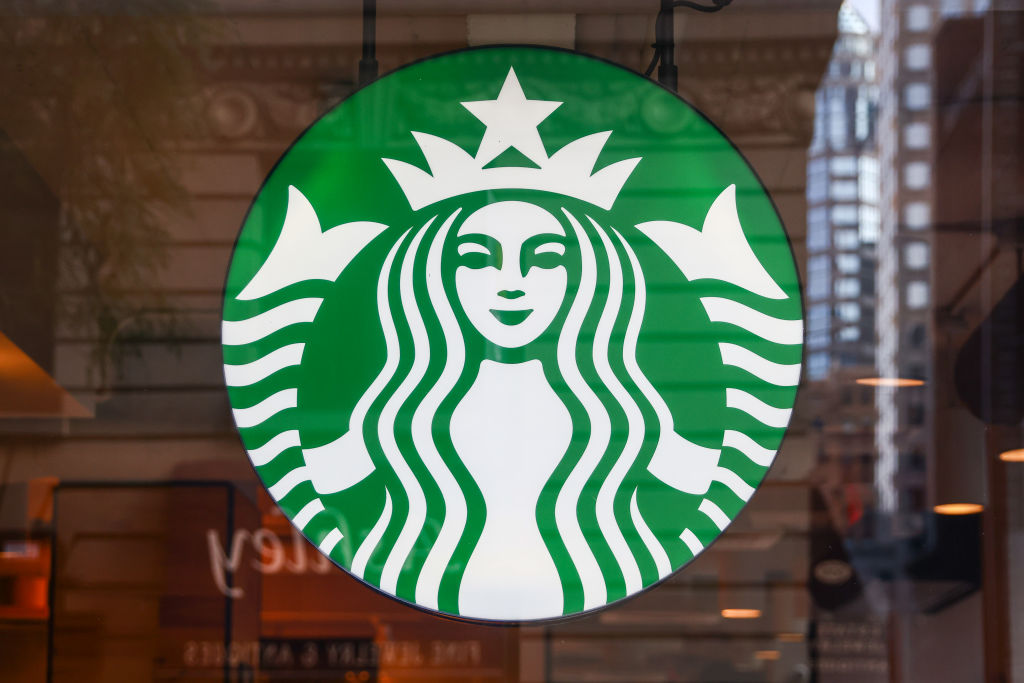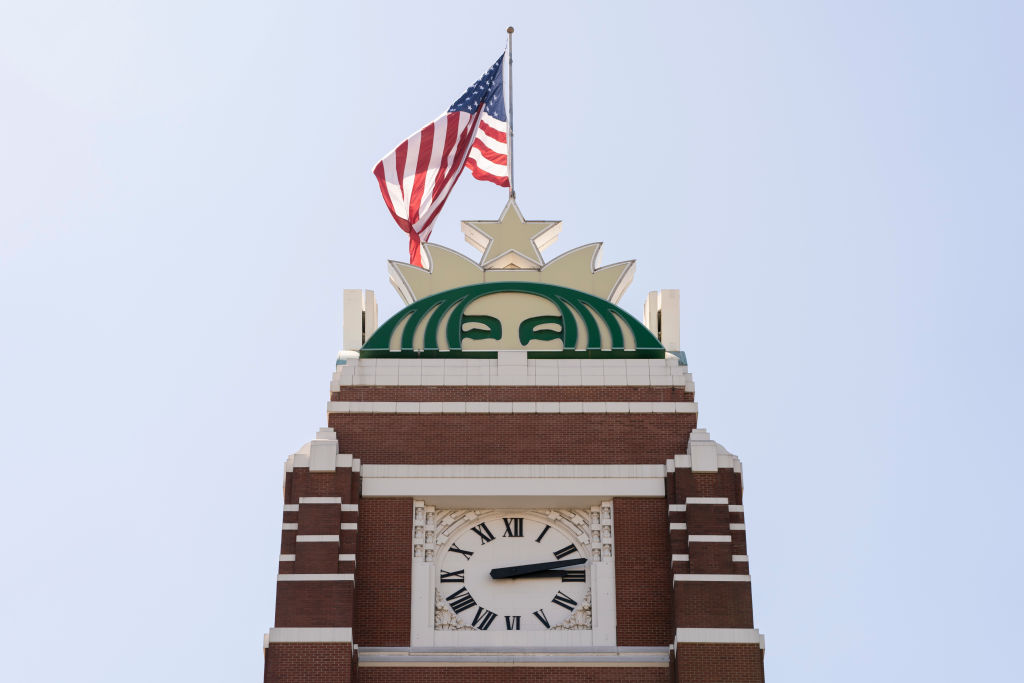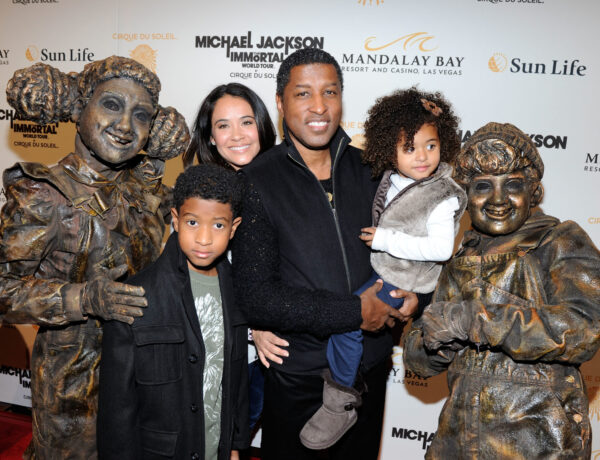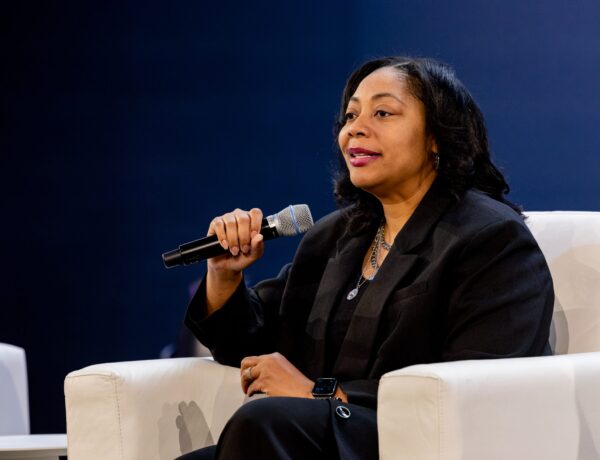Almost everyone is familiar with the mermaid branded barista coffee chain offering a premium brew with faux Italian charm. Founded in 1971 in Seattle, Starbucks Coffee has long since been an international sensation. From humble beginnings at its flagship store in Pike Place (the first Starbucks location), to outposts in far-flung locales around the world, almost everyone is familiar with Starbucks.
Today, Starbucks boasts over 38,000 locations serving more than 80 countries with its signature brews and even customized treats unique to the cultural tastes of each region. From airports to hotels, dabbling in the venture capital world, and even consumer packaged goods for coffee lovers to enjoy favorite items at home, there’s no stopping this iconic brand. And this leads to the inevitable question, just how much is Starbucks’ net worth — or in the case of a business, market cap?
Humble Beginnings

(Photo by Beata Zawrzel/NurPhoto via Getty Images)
Starbucks first opened its doors on March 30, 1971, in Pike Place Market in Seattle. The original store was only 1,000 square feet and was manned by a single employee according to the brand’s history portal on the Starbucks website. The original founders were Jerry Baldwin, Zev Siegl, and Gordon Bowker who met as students at the University of San Francisco.
Starbucks fans may be surprised to learn that the original idea for the coffee store was inspired by Peet’s Coffee & Tea which was run by coffee entrepreneur Alfred Peet. He later went on to teach Starbucks employees how to properly brew coffee beans. In the early days, Starbucks only sold coffee beans as freshly made drinks wouldn’t appear on menus until the late 1980s. During this time, the brand’s green coffee beans were sourced from Peet’s Coffee.
Rapid Growth And Development
In 1984, Starbucks made the bold step to purchase Peet’s Coffee and later started offering espresso on its menus by 1986. In 1987 the original trio of owners later sold their shares to Starbucks’ former director of marketing Howard Shultz who oversaw the coffee brand’s rapid growth. He would serve as CEO twice in the company’s history (1986 to 2000 and again from 2008 to 2017) before being succeeded by Laxman Narasimhan.
Schultz was also in the coffee business, with a small chain of coffee shops known as Il Giornale. He chose to rebrand these locations as Starbucks, exponentially expanding the brand’s footprint. During this time, the coffee retailer finally expanded beyond Seattle and boasted 46 locations across the Pacific Northwest and Midwest by 1989.
Starbucks Goes Public

One of the biggest signs that a business is heading in the right direction is when its stakeholders decide to go public. In June 1992, Starbucks made its initial public offering (IPO) and is still traded publicly today on the Nasdaq. At that time, the brand had 140 locations and was earning an annual revenue of $73.5 million — compared to just $1.3 million in 1987 when Shultz took over the firm.
Starbucks’ net worth, or rather its market cap, continued to climb. The 1992 revenue translated to a $271 million market value at the time. To launch the IPO, the brand opted to offer a 12% stake in the company, raising roughly $25 million which was used to further scale the business in the following two years.
Expansion And Acquisition

After going public, Starbucks enjoyed not just significant growth via expansion, but also through acquisitions of potential regional competitors. In 1994, the brand acquired The Coffee Connection which was known for its Frappuccino beverages. This gave Starbucks the rights to market frozen coffee beverages under the same name in 1995.
Pasqua Coffee, another regional coffee chain with outposts in the Bay Area, Los Angeles, and New York, was also acquired in 1999. This boosted Starbucks’ footprint with an additional 60 stores across those three cities. In 2003, the barista brand later acquired Seattle’s Best Coffee and Torrefazione Italia.
This translated to an additional 150 stores but the bigger boon was the acquisition of the accompanying wholesale business from those two brands. Rounding out the early 2000s acquisitions was the purchase of Coffee Equipment Company which allowed Starbucks to create proprietary brewing equipment including the “fresh-pressed” coffee systems which were tested in select locations across key cities like Seattle, New York, and Boston.
The Great Recession Hits Hard For Starbucks
Virtually every company was impacted by the Great Recession of 2008 and Starbucks was no exception. In July of that year, the company announced that 600 underperforming stores were set to close and that previous expansion plans were on hold because of the economic uncertainty. Another part of this paring down included cutting nearly 1,000 non-retail jobs which included 550 layoffs.
The Great Recession also saw Starbucks shutter 72% of its Australian locations, bringing the number of stores down to 23 from 84. By late 2009 Starbucks had cut over 18,000 jobs in the U.S., and closed nearly 1,000 stores worldwide. This also included in-store Starbucks kiosks in grocers like Stop & Shop and Giant stores.
Starbucks’ Digital Era and Strategic Locations
Eventually, the economy began to rebound and Starbucks looked to the digital world to stake its claim. One of the first rollouts was digital ordering and purchasing through the Starbucks app. This accounted for more than 10% of in-store purchases by mid-July 2013.
Other initiatives included a “bean to cup” campaign that allowed Starbucks consumers to connect with local coffee bean farmers in Colombia. This campaign emerged from the firm’s pledge to only use 100% ethically sourced coffee beans. By allowing consumers to use the blockchain platform to essentially track beans, it created transparency. Not only did coffee lovers get to learn where their beans were harvested, but the platform also shared how Starbucks was giving back or assisting the local communities where beans were sourced.
The 2010s saw Starbucks consistently repositioning locations and shuttering doors that were redundant. Closures were more prevalent in metropolitan areas where rapid expansion resulted in too many locations in close proximity to each other — which caused underperformance at the store level.
During this era, Starbucks divested of its Australian portfolio choosing to sell the remaining stores to the local Withers Group. By contrast, in China Starbucks purchased the other 50% of the previously foreign-held holdings from its joint venture partner in that market.
Starbucks, COVID-19, And More Expansion
Like many businesses, Starbucks was also impacted by the COVID-19 shutdown. Between temporary closures and shifting to a drive-thru and delivery-only model, Starbucks experienced a 10% drop worldwide but a more severe 50% drop in sales in China where quarantine guidelines were significantly stricter.
COVID-19 fallout led to Starbucks announcing plans to close 400 locations across the U.S. and Canada within the following 18 months. However, this setback was temporary as by December 2020, the firm shared plans to increase the store count within the next 10 years by 22,000 locations — up from the then 33,000 stores in the brand’s portfolio.
Starbucks Controversies

As with any corporation that’s been around as long as Starbucks, it’s no surprise that there have been a few controversies over the years. There have been long-standing claims of racial bias dating back as far as 1994 both at the store and corporate level for employees and customers. Most notable was in 2018 when two Black men at a local Philadelphia Starbucks were arrested because staffers thought they looked suspicious. This prompted the company to close 8,000 stores for a day to provide racial bias training to its staff.
Additionally, Starbucks has been accused of employing union busting tactics such as temporarily or permanently closing locations that also happened to be epicenters for pro-union campaigns from its employees. Similarly, political tightrope walking over LGBTQ+ rights and the current Israel-Hamas war have caused Starbucks to face boycotts and increased scrutiny from consumers.
Starbucks’ Current Market Capitalization
Those looking for Starbucks’ net worth might find themselves confused in the tangles of terminology. Unlike people, companies are not traditionally measured in net worth. Instead, companies are rated by market capitalization, revenue, and profit. Starbucks is undeniably an incredibly profitable company. As of the time of publication of this article, Starbucks has a market cap of $109.35 billion and an enterprise value of $131.30 billion. The current market cap represents a 0.20% increase since 2023 when the company closed the year out at $109.13 billion.




